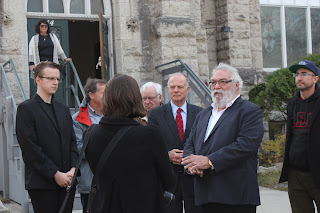Gerrard
will create a task force to develop basic income
program
ready for 2020.
develop
a province-wide basic income program for all Manitobans.
Jon
Gerrard said, “Should I be elected leader of the Manitoba Liberal party on
October 21, one
of
my first acts will be to appoint David Northcott as chair of a task force to
develop the basic
income
program. He will utilize his experience with Winnipeg Harvest along with
guidance
from
those with lived experience to create it."
A
basic income, or guaranteed minimum income program, has been talked about for
years, and
pilots
are underway currently in Ontario
will
include supports for community and social engagement through volunteerism. The
program will decrease poverty and protect the dignity of recipients while
maintaining essential services
“In
my training as an economist, and subsequently, I have watched the work on a
basic income
program
as it has evolved, and I believe the time is now to deliver it,” said Gerrard.
“It is
important
now, more than ever, not just to help those who are poor, but to ensure a basic
income
level for those who find themselves out of work and in transition to a new job.
It
will allow, for example, a more adequate period of retraining than is allowed
under current
programs.”
The
Task Force will include Sid Frankel, Associate Professor of the University of Manitoba
Faculty
of Social Work, and Les Johnson, Economist and President of The Manitoba
Institute of Management, as well as the chair David Northcott, former executive
director of Winnipeg Harvest. “I am excited by the prospect of designing a
workable system for Manitoba,” said Northcott. “I have long dreamed of the day
when we could have a basic income program to support people to reduce poverty
and reduce the need for food banks.”
“As
a political economist, I believe this program could be revenue neutral in 4
years,” said Les
Johnson,
“it can quickly become a matter of fact with a tax revenue analysis.”
See this link for a short video of announcement
See this link for a short video of announcement





Comments
Post a Comment